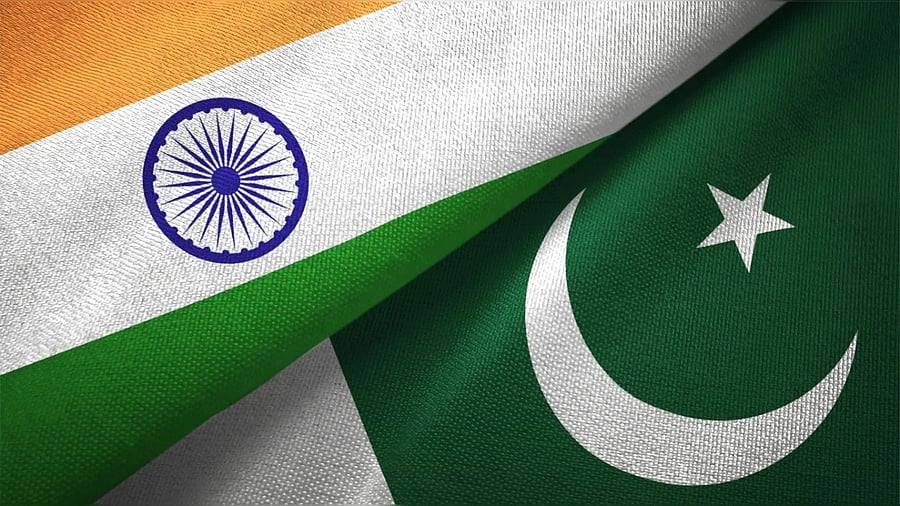
Flag of India and Flag of Pakistan.
Credit: iStock Photo
New Delhi: Pakistan succeeded in the four-day conflict with India between May 7 and 10, and China took advantage of the four-day military flare-up between the two South Asian neighbours to test and advertise the sophistication of its weapons, a report by a commission of the United States government has claimed.
“Pakistan’s military success over India in its four-day clash showcased Chinese weaponry,” the US-China Economic and Security Review Commission (USCC) noted in its latest report. “While characterisation of this conflict as a ‘proxy war’ may overstate China’s role as an instigator, Beijing opportunistically leveraged the conflict to test and advertise the sophistication of its weapons, useful in the contexts of its ongoing border tensions with India and its expanding defence industry goals,” the USCC added in its report presented to the US Congress recently.
The US commission’s claim about “Pakistan’s military success over India” contradicts the statements of the political leaders and senior defence officials in New Delhi. Prime Minister Narendra Modi, himself, had stated that India had showcased its capabilities during “Operation Sindoor” and brought Pakistan to its knees within a few hours.
The report presented to the US Congress noted that China’s fighter jets and air-to-air missiles had received their first combat use as Pakistan “successfully flew” them during the four-day conflict with India. “This marks the first known instance of these systems being tested in actual combat, providing the (Chinese) PLA (People’s Liberation Army) valuable data and potentially boosting the credibility of China’s defence exports,” noted the commission, created by the American Congress in October 2000 with the legislative mandate to monitor, investigate, and submit an annual report on the national security implications of bilateral trade and economic relationship between the US and the People’s Republic of China.
The USCC referred to the India-Pakistan conflict in its report even as President Donald Trump continued to disregard New Delhi’s rebuttals and kept reiterating his claims about brokering a ceasefire deal that ended the four-day conflict between the two South Asian neighbours.
The report presented to the US Congress noted that China initiated a disinformation campaign after the May 7-10 India-Pakistan conflict to hinder sales of French Rafale aircraft in favour of its own J-35s. It noted that China had used fake social media accounts to propagate images generated by Artificial Intelligence of supposed “debris” from India’s fighter jets that Pakistan had destroyed using China’s weaponry.
It took note of the claim of the military officials in New Delhi that China had helped Pakistan by providing “live inputs” on military positions of India throughout the conflict and effectively used the conflict as a testing ground for its own military capabilities.
“In the weeks after the conflict, China’s embassies hailed the successes of its systems in the India-Pakistan clash, seeking to bolster weapons sales,” the USCC noted, adding: “Pakistan’s use of Chinese weapons to down French Rafale fighter jets used by India also became a particular selling point for Chinese embassies’ defence sales efforts, despite the fact that only three jets flown by India’s military were reportedly downed, and all may not have been Rafales.”
China provided approximately 82 per cent of Pakistan’s arms imports from 2019 to 2023. The India-Pakistan clash between May 7-10 was the first time China’s modern weapons systems, including the HQ-9 air defence system, PL-15 air-to-air missiles, and J-10 fighter aircraft, were used in active combat, serving as a real-world field experiment, the US commission reported. It also noted that China had reportedly offered to sell 40 J-35 fifth-generation fighter jets, KJ-500 aircraft, and ballistic missile defence systems to Pakistan in June 2025. Pakistan had in the same month announced a 20 per cent increase in its 2025–2026 defence budget, raising planned expenditures to $9 billion despite an overall budget decrease, added the USCC.
After the terrorists from Pakistan and the areas illegally occupied by Pakistan killed 26 people – mostly tourists – in Pahalgam in J&K, India launched ‘Operation Sindoor’ early on May 7, targeting the training camps of the Jaish-e-Mohammed and Lashkar-e-Tayyiba across its Line of Control (LoC) as well as the undisputed stretch of its border with its western neighbour. Pakistan responded by targeting military facilities and the civilian population in India. The cross-border flare-up came to its end with a ceasefire on May 10.
